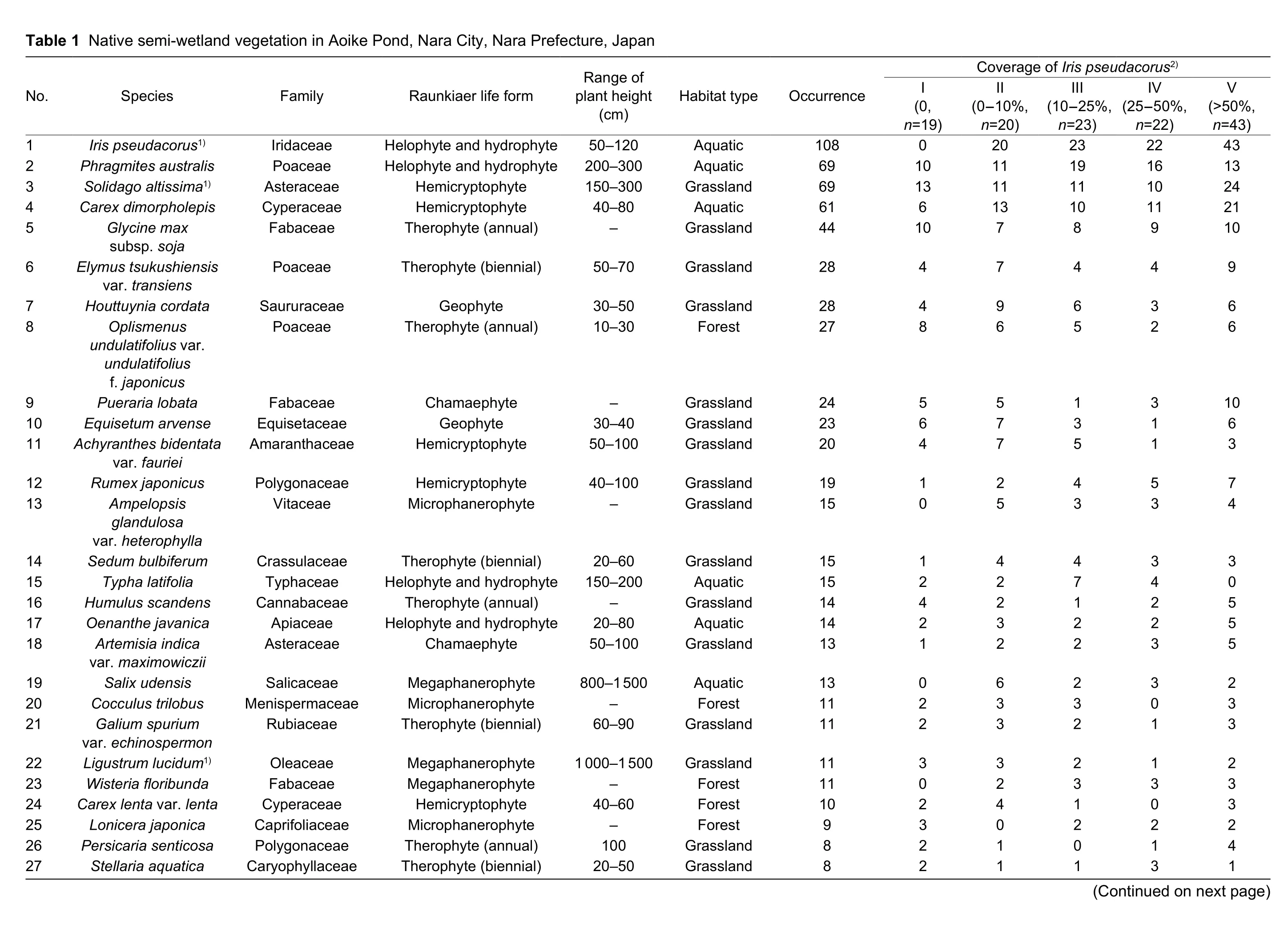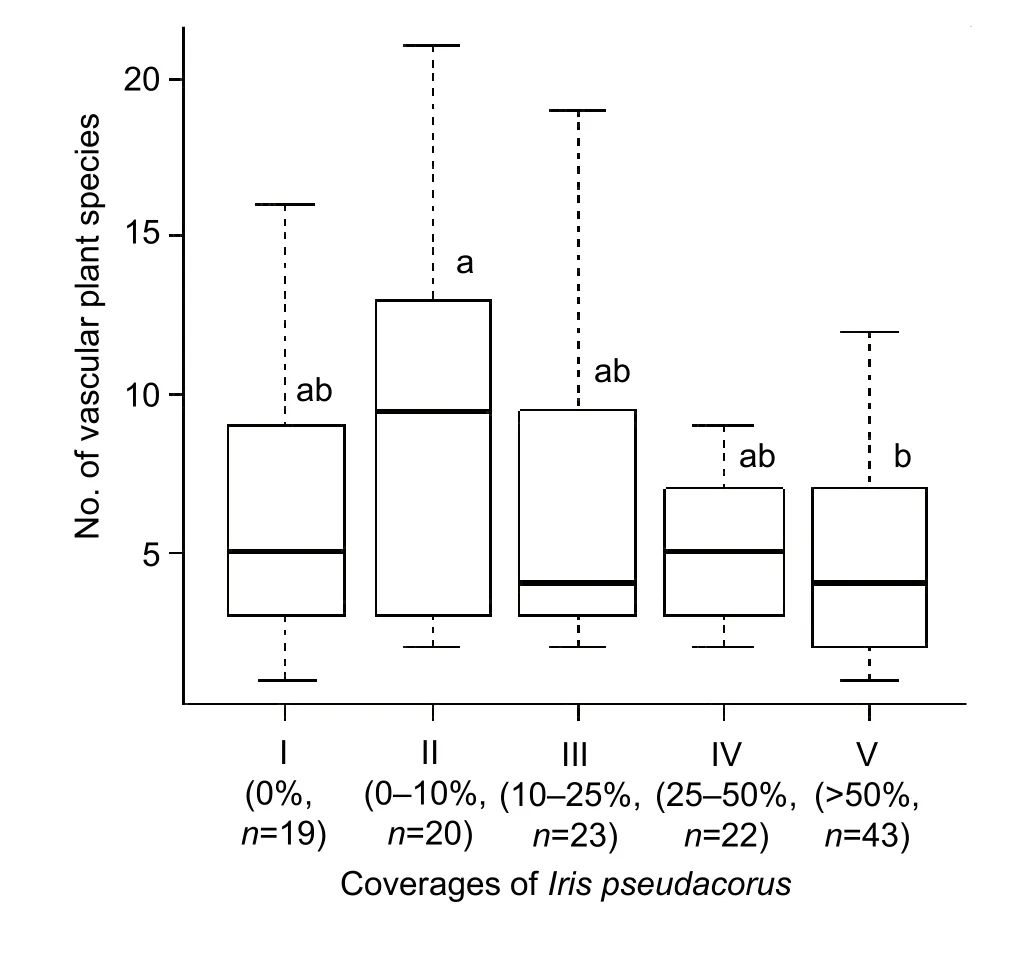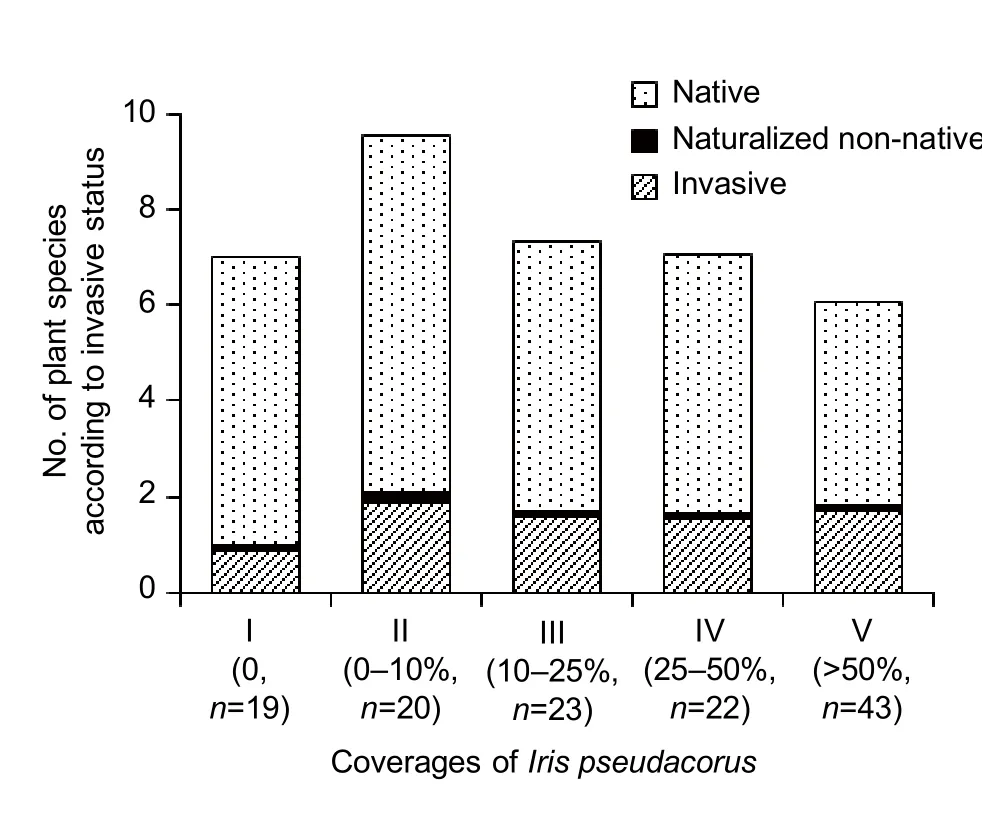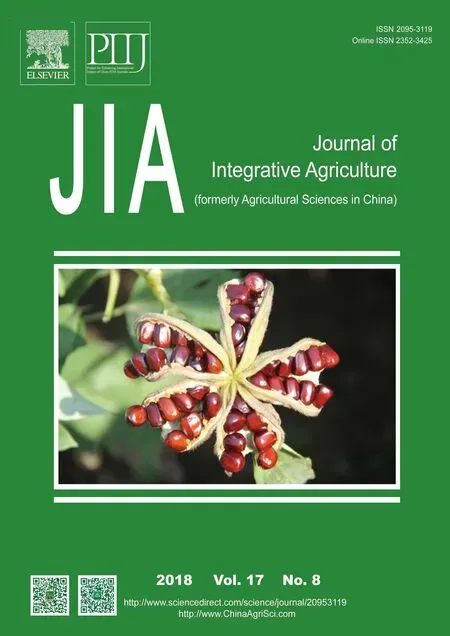lmpacts of invasive Iris pseudacorus L. (yellow flag) establishing in an abandoned urban pond on native semi-wetland vegetation
Daisuke Hayasaka, Shingo Fujiwara, Taizo Uchida
1 Graduate School of Agriculture, KINDAI University, Nara 631-8505, Japan
2 Faculty of Engineering, Kyushu Sangyo University, Fukuoka 813-8503, Japan
Abstract Iris pseudacorus L., intentionally introduced in Japan as an ornamental plant and to improve aquatic environments, has been declared a noxious species in the Invasive Alien Species Act of Japan due to the suspected high ecological risks to the local species and ecosystems. Although prompt responses to I. pseudacorus have been sought to conserve local biodiversity,knowledge about its invasiveness is lacking. Here, we report the relationship between the establishment of I. pseudacorus and floristic changes in semi-wetland vegetation of an abandoned urban pond (Aoike), Nara City, Nara Prepecture, Japan.In total, 64 vascular plants were recorded in the pond, of which 50 were native species, seven were naturalized non-native,and seven were invasive species. On the other hand, most of these vascular plants (42 species) were grassland species and only several aquatic plants (10 species) were found in this study pond. The number of vascular plant species decreased significantly at quadrats with a coverage of I. pseudacorus above 50%. In addition, tendencies of lower number of native species and concomitant higher number of invasive species were found with increasing coverage of I. pseudacorus. From these results, we suggest that it is important to preferentially manage sites where the coverage of I. pseudacorus is above 50%, in order to preserve the local biodiversity. Additionally, as recommended in the literature, it is essential that the cut reproductive organs are kept submerged under deep water for an effective control of I. pseudacorus.
Keywords: biodiversity conservation, biological invasions, ecological impacts, exotic species, hydrophytes, species traits
1. lntroduction
There is growing concern about the impacts of biological invasions on natural ecosystems (e.g., Hulme 2007; Stierset al. 2011). Although the balance of each local ecosystem has been stabilized over time, a single invasive species can easily cause adverse effects on ecosystem services (Vilàet al. 2010).
Iris pseudacorusL. (yellow flag), native to Europe, is a useful emerged aquatic plant for vegetation restoration and phytoremediation of heavy-metals (Zhouet al. 2010;Caldelaset al. 2012; Xuet al. 2015) and nutrients (Wuet al.2013; Keizer-Vleket al. 2014). However, the species has a high ability of seed dispersal by water (i.e., hydrochory)and of vegetative propagation from subterranean organs(Jaca 2013). Aquatic environments including river and ditch are particularly impacted by biological invasion of aquatic exotic plants (e.g., Brown and Peet 2003; Nilssonet al. 2010; Hussner 2012). Furthermore, the sediments of ponds hold persistent seed banks of many species,and water level fluctuations induce recruitment from these seed banks (Leck 1989). Also, given its likely hybridization with related species such asIris laevigataFisch.,I.pseudacorushas been declared an invasive species that requires special attention (i.e., alerted alien species, AAS)in the Invasive Alien Species Act of Japan (Ministry of the Environment, Japan 2005b). Because invasive species has rapidly expanded worldwide, it is very important to clarify the impacts and mechanisms of biological invasion of each exotic species for their effective control and/or eradication(Levineet al. 2003). However, knowledge about the invasiveness ofI.pseudacorus, except for the conflict with nativeIrisspecies (Pathikondaet al. 2009) and its ability of rapid vegetative propagation (Jaca 2013), is lacking.
Here, we report the impacts ofI.pseudacorusin an abandoned urban pond of Japan on the native semi-wetland vegetation, in order to obtain information for its control and management of the local biodiversity.
2. Materials and methods
2.1. Study site
Surveys ofI.pseudacorusand semi-wetland vegetation were conducted at Aoike pond (1.32 ha), Nara City, Nara Prefecture, Japan (34°42´04.4´´N and 135°45´11.6´´E).Since the landscape fragmentation caused by an increased urbanization (McKinney 2006), Aoike has been isolated from other surrounding green areas. In addition, the pond has been abandoned for over three decades, as its water storage function was lost. Consequently, Aoike became a static,semi-wetland environment due to reduced water supply into the pond other than rainfall and progressive siltation.Apart fromI.pseudacorusother AAS species such asSolidago altissimaL. andBidens frondosaL. have also been established in the pond. Weeding management in Aoike pond is limited to parts of slopes cut, while anthropogenic disturbances to the central parts of the pond (i.e., semiwetland areas) are scarce or inexistent.
2.2. Vegetation survey
A survey of the semi-wetland vegetation in Aoike was conducted from late May to early July 2013. Firstly, we divided the semi-wetland areas of the pond into 127 plots(10 m×5 m size) and recorded the coverage ofI.pseudacorusin each plot using five categories as follows:I, 0%; II, 0–10%; III, 10–25%; IV, 25–50%; and V, >50%.Then, in total, 127 quadrats (2 m×2 m size) were placed at the center of each plot and the semi-wetland vegetation including invasiveI.pseudacoruswas surveyed in accordance with the methodology of Braun-Blanquet (1964).The coverage on all vascular plants in each quadrat was classified as follows: +, under 1%; 1, 1–10%; 2, 10–25%;3, 25–50%; 4, 50–75%; and 5, >75%. Nomenclature of each plant recorded and their height followed Satakeet al.(1981,1982a, b,1989a, b), Shimizu (2003), and Ohashiet al. (2008). We compiled a dataset for invasive status(native, naturalized non-native, and invasive) of all the recorded species, in order to characterize the vegetation surveyed (Hayasakaet al. 2012a, b). We distinguished naturalized non-native and invasive species from native species by using information about their invasiveness taken from the published literature on naturalized plants(Richardsonet al. 2000; Shimizu 2003) and organisms listed under the Invasive Alien Species Act of Japan (Ministry of the Environment, Japan 2005ab). Species’ life forms were also categorized into dormancy forms based on Raunkiaer(1934) as an additional information. Plants were classified as annuals and/or biennial (therophyte), perennials(chamaephyte, hemicryptophyte, geophyte, helophyte, and hydrophyte), shrubs (microphanerophyte), sub-canopy trees(mesophyte), or canopy trees (megaphanerophyte) following Numata and Yoshizawa (1968), Satakeet al. (1981,1982a,b,1989a, b), and Numata (1990).
2.3. Data analysis
Differences in the number of vascular plant species among the coverage ofI.pseudacoruswere analyzed by analysis of variance (ANOVA) and/or Kruskal-Wallis (KS) test, with the null hypothesis being that the number of vascular plant species are equivalent among the coverages.Scheffe’s test (ANOVA) and Steel-Dwass test (KS) were conducted as a Post Hoc test to examine the difference between the coverages. To test the interaction between the number of plant species according to invasive status andI.pseudacoruscoverages, we conducted KS test (null hypothesis being that the species number of each invasive status does not depend on the coverage ofI.pseudacorus).These data analyses were carried out using the statistical software SPSS Statistics ver. 21 for Windows (IBM Corp.,Tokyo, Japan) and the free statistical software R ver.3.2.0(R-Development-Core-Team 2015).
3. Results and discussion

?

?

?
A total of 64 vascular plant species were recorded in the 127 quadrats of Aoike pond (Table 1), of which 50 were native species. The number of naturalized non-native and invasive species including AAS species was seven,respectively. On the other hand, most of the semi-wetland vegetation (42 species) were grassland species and only several aquatic plants (10 species) were found in this study pond (Table 1), suggesting that structures of the community have largely deflected. This phenomenon would be derived from the progression of vegetation succession due to the loss of water storage function of Aoike pond for over three decades. There was a significant relationship between the number of vascular plant species and the coverages ofI. pseudacorus(df=4,F=2.612,P=0.05) and particularly, species richness was significantly lower in quadrats where the coverage ofI.pseudacoruswas more than 50% (P<0.05) (Fig. 1).I. pseudacorusis a tall emergent plant (above 1.2 m maximum height). Among the vegetation recorded in Aoike, 16 species(25% of total) were low herbaceous plants below 50–60 cm height (Table 1). Weak relationships between the number of smaller vascular plants and invasiveI.pseudacoruscoverage were found (df=4,χ2=8.839,P=0.06), suggesting that some of these vascular plants (e.g.,Commelina communisL.,Corydalis incisa(Thunb.) Pers., andJuncus setchuensisBuchenau var.effusoidesBuchenau), which were native species, would be affected asI.pseudacorusgrow taller and overshadow the smaller plants. The number of invasive species, including AAS,was clearly lower only in quadrats withoutI.pseudacorus(df=4,χ2=16.271,P<0.01) (Fig. 2). Significant low number of native species was found at sites where the coverage ofI.pseudacorusis above 50% (df=4,χ2=9.428,P<0.05). It suggests that tendencies of low number of native species and concomitant high number of invasive species were found with increasing coverage ofI.pseudacorus (P<0.05). On the other hand,there was no clear difference in the number of naturalized non-native species among the coverages ofI.pseudacorus(df=4,x2=0.295,P=0.99) (Fig. 2). Similar trends are reported for many other exotic species (e.g., Akasaka and Tsuyuzaki 2009; Muranaka 2012). Although we reveal here some ecological traits ofI.pseudacorusthat impact on native semi-wetland vegetation of an abandoned urban pond,further research on the invasiveness ofI.pseudacorusis required for its effective control and/or eradication. Pyšek and Richardson (2010) also indicate that continuous monitoring is extremely important to assess accurate risks of invasive species.

Fig. 1 Differences in the number of vascular plant species in Aoike Pond of Japan for various coverages of Iris pseudacorus.Same letters above the boxes indicate no statistical difference(P>0.05) among I. pseudacorus coverages, ANOVA using Scheffe’s test. n indicates the number of quadrats for each I. pseudacorus coverage category.
I. pseudacoruseasily expands its population by vegetative propagation from rhizomes (Jaca 2013). It takes a lot of time, effort, and money to plow and cut out the rhizomes ofI.pseudacorus. Jaca (2013) showed, however, the effectiveness of cutting rhizomes and stems for controlling the propagation of this invasive species. The cutting management technique of invasive macrophytes have been reported by many researchers (e.g., Baattrup-Pedersenet al. 2003; Berget al. 2012). Weiet al. (2014) showed that the cutting of submerged reproductive organs in water is one of the most effective measures for controlling the emergent macrophyteAcorus calamusL. The germination ofI.pseudacorusalso becomes restricted under water(Gedeboet al. 1998; Nakashima and Oki 2005). Thus, the regulation of the water level can be one of key factors to controlI.pseudacorusby covering the rhizomes with water after cutting them.

Fig. 2 Number of plant species according to invasive status(native, naturalized non-native, and invasive species), recorded in Aoike pond of Japan among Iris pseudacorus coverages.n indicates the number of quadrats for each coverage of I. pseudacorus.
4. Conclusion
Based on our research here, we recommend to preferentially manage sites where the coverage ofI.pseudacorusis above 50% for its effective control and/or eradication, so the native semi-wetland plant diversity can be preserved and given an advantage to expand (Fig. 2). In addition, it would be most effective if reproductive organs such as rhizomes and stem segments are cut and kept submerged under deep water.Another problem is that seeds ofI.pseudacoruscan be dispersed widely by water, but by controlling the emergence of new stems from rhizomes the overall seed production is also reduced to a minimum.
Acknowledgements
We thank Mr. Kentaro Fujiwara and Mr. Takanobu Ishida(KINDAI University, Japan) for their kind assistance with field survey. The authors wish to thank Ms. Asako Hama,for valuable comments of the history of Aoike pond. We are indebed to Dr. Katsumasa Yamada (Kumamoto University,Japan) for technical advice. The paper benefited from the constructive comments of two anonymous reviewers.
 Journal of Integrative Agriculture2018年8期
Journal of Integrative Agriculture2018年8期
- Journal of Integrative Agriculture的其它文章
- Is the “One Province One Rate” premium policy reasonable for Chinese crop insurance? The case in Jilin Province
- What determines irrigation efficiency when farmers face extreme weather events? A field survey of the major wheat producing regions in China
- Changes in soil biochemical indicators at different wheat growth stages under conservation-based sustainable intensification of rice-wheat system
- Accumulation and bioavailability of heavy metals in a soil-wheat/maize system with long-term sewage sludge amendments
- Effects of long-term green manure application on the content and structure of dissolved organic matter in red paddy soil
- iTRAQ-based quantitative proteomic analysis reveals key pathways responsible for scurs in sheep (Ovis aries)
